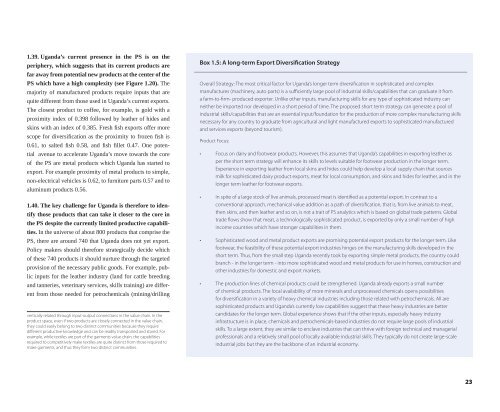Economic Diversification and Growth
71mK301zeG0
71mK301zeG0
Create successful ePaper yourself
Turn your PDF publications into a flip-book with our unique Google optimized e-Paper software.
1.39. Ug<strong>and</strong>a’s current presence in the PS is on the<br />
periphery, which suggests that its current products are<br />
far away from potential new products at the center of the<br />
PS which have a high complexity (see Figure 1.20). The<br />
majority of manufactured products require inputs that are<br />
quite different from those used in Ug<strong>and</strong>a’s current exports.<br />
The closest product to coffee, for example, is gold with a<br />
proximity index of 0.398 followed by leather of hides <strong>and</strong><br />
skins with an index of 0.385. Fresh fish exports offer more<br />
scope for diversification as the proximity to frozen fish is<br />
0.61, to salted fish 0.58, <strong>and</strong> fish fillet 0.47. One potential<br />
avenue to accelerate Ug<strong>and</strong>a’s move towards the core<br />
of the PS are metal products which Ug<strong>and</strong>a has started to<br />
export. For example proximity of metal products to simple,<br />
non-electrical vehicles is 0.62, to furniture parts 0.57 <strong>and</strong> to<br />
aluminum products 0.56.<br />
1.40. The key challenge for Ug<strong>and</strong>a is therefore to identify<br />
those products that can take it closer to the core in<br />
the PS despite the currently limited productive capabilities.<br />
In the universe of about 800 products that comprise the<br />
PS, there are around 740 that Ug<strong>and</strong>a does not yet export.<br />
Policy makers should therefore strategically decide which<br />
of these 740 products it should nurture through the targeted<br />
provision of the necessary public goods. For example, public<br />
inputs for the leather industry (l<strong>and</strong> for cattle breeding<br />
<strong>and</strong> tanneries, veterinary services, skills training) are different<br />
from those needed for petrochemicals (mining/drilling<br />
vertically related through input-output connections in the value chain. In the<br />
product space, even if two products are closely connected in the value chain,<br />
they could easily belong to two distinct communities because they require<br />
different productive knowledge <strong>and</strong> can be readily transported <strong>and</strong> stored. For<br />
example, while textiles are part of the garments value chain, the capabilities<br />
required to competitively make textiles are quite distinct from those required to<br />
make garments, <strong>and</strong> thus they form two distinct communities.<br />
Box 1.5: A long-term Export <strong>Diversification</strong> Strategy<br />
Overall Strategy: The most critical factor for Ug<strong>and</strong>a’s longer term diversification in sophisticated <strong>and</strong> complex<br />
manufactures (machinery, auto parts) is a sufficiently large pool of industrial skills/capabilities that can graduate it from<br />
a farm-to-firm- produced exporter. Unlike other inputs, manufacturing skills for any type of sophisticated industry can<br />
neither be imported nor developed in a short period of time. The proposed short term strategy can generate a pool of<br />
industrial skills/capabilities that are an essential input/foundation for the production of more complex manufacturing skills<br />
necessary for any country to graduate from agricultural <strong>and</strong> light manufactured exports to sophisticated manufactured<br />
<strong>and</strong> services exports (beyond tourism).<br />
Product Focus:<br />
• Focus on dairy <strong>and</strong> footwear products. However, this assumes that Ug<strong>and</strong>a’s capabilities in exporting leather as<br />
per the short term strategy will enhance its skills to levels suitable for footwear production in the longer term.<br />
Experience in exporting leather from local skins <strong>and</strong> hides could help develop a local supply chain that sources<br />
milk for sophisticated dairy product exports, meat for local consumption, <strong>and</strong> skins <strong>and</strong> hides for leather, <strong>and</strong> in the<br />
longer term leather for footwear exports.<br />
• In spite of a large stock of live animals, processed meat is identified as a potential export. In contrast to a<br />
conventional approach, mechanical value addition as a path of diversification, that is, from live animals to meat,<br />
then skins, <strong>and</strong> then leather <strong>and</strong> so on, is not a trait of PS analytics which is based on global trade patterns. Global<br />
trade flows show that meat, a technologically sophisticated product, is exported by only a small number of high<br />
income countries which have stronger capabilities in them.<br />
• Sophisticated wood <strong>and</strong> metal product exports are promising potential export products for the longer term. Like<br />
footwear, the feasibility of these potential export industries hinges on the manufacturing skills developed in the<br />
short term. Thus, from the small step Ug<strong>and</strong>a recently took by exporting simple metal products, the country could<br />
branch - in the longer term - into more sophisticated wood <strong>and</strong> metal products for use in homes, construction <strong>and</strong><br />
other industries for domestic <strong>and</strong> export markets.<br />
• The production lines of chemical products could be strengthened. Ug<strong>and</strong>a already exports a small number<br />
of chemical products. The local availability of more minerals <strong>and</strong> unprocessed chemicals opens possibilities<br />
for diversification in a variety of heavy chemical industries including those related with petrochemicals. All are<br />
sophisticated products <strong>and</strong> Ug<strong>and</strong>a’s currently low capabilities suggest that these heavy industries are better<br />
c<strong>and</strong>idates for the longer term. Global experience shows that if the other inputs, especially heavy industry<br />
infrastructure is in place, chemicals <strong>and</strong> petrochemicals-based industries do not require large pools of industrial<br />
skills. To a large extent, they are similar to enclave industries that can thrive with foreign technical <strong>and</strong> managerial<br />
professionals <strong>and</strong> a relatively small pool of locally available industrial skills. They typically do not create large-scale<br />
industrial jobs but they are the backbone of an industrial economy.<br />
23


